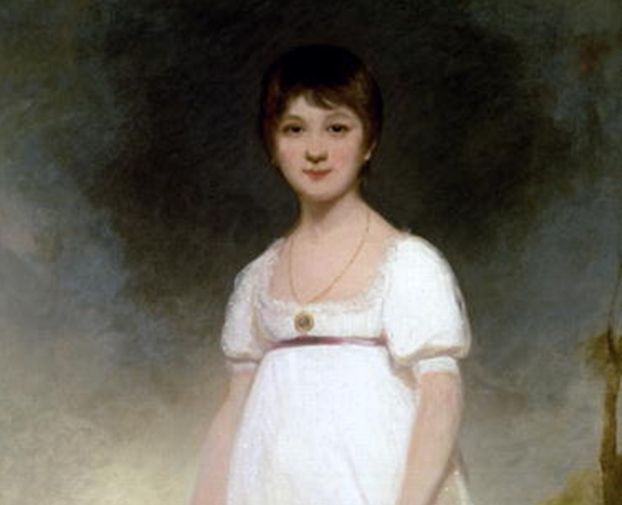Is This Jane Austen as a Teen?

Is this innocent looking girl in white dress the true depiction of British novelist Jane Austen as a teenager?
According to a report in the Guardian, new evidence would suggest that the artwork, one of the most controversial paintings in literary portraiture, is indeed depicting the author of "Pride and Prejudice," "Sense and Sensibility," "Emma" and "Mansfield Park," when she was 13.
Digital photographic analysis on old photographs of the painting, taken before it was restored, revealed the novelist's name and the artist who composed the portrait, the British daily said.
The discovery could end a more than a century-old debate.
Owned by the Rice family, sixth-generation descendants of Jane's brother Edward, the portrait first appeared in the public eye in 1884, nearly 70 years after the author's death. At that time, it was featured in the first published collection of Austen's letters.
According to the Rice family, the painting was produced during an Austen family visit to the house of Jane's great uncle Francis in Kent in 1789.
A wealthy lawyer, Francis Austen, would have commissioned the portrait to help Jane's marriage prospects.
Sign up for the Live Science daily newsletter now
Get the world’s most fascinating discoveries delivered straight to your inbox.
Shortly after Jane's death in 1817 at the age of 41, the portrait was given by Colonel Thomas Austen, Francis Austen's grandson, to a close friend, Elizabeth Harding-Newman, who was a keen admirer of Austen's books.
The portrait remained within the Harding-Newman family and passed to the Rice family in 1882, at the death of Revd Thomas Harding-Newman.
"The identification of the portrait as Jane Austen hinges on the memory of this one man, outside the Austen family, writing many years after events in which he was not involved," Jacob Simon wrote as he retired as chief curator to the National Portrait Gallery in October 2011.
"Do we believe Newman's claim in 1880 that Colonel Thomas Austen, Jane Austen's cousin gave away the portrait of the most celebrated member of the Austen family to a friend outside the family...or Jane Austen's brother and literary executor, Henry Austen, who stated in 1832 'No likeness ever was taken of Miss Austen'?," Simon wrote.
The portrait's authenticity was questioned long before Simon. Already in 1948, Austen scholar RW Chapman stated that the girl's costume showed the picture was painted in the beginning of the 19th century, when Austen would have been well out of her teens.
Subsequently, other historians argued that short full sleeves, high waistline, and long skirt were not in existence when Jane was a teenager.
"It has taken my late husband Henry, my son, myself and my brother Robin Roberts over 40 years to overturn the decision made in the early 1940s by the National Portrait Gallery, that our picture was not of Jane Austen the novelist, but some other sitter," Anne Rice wrote in the The Rice Portrait website.

Showing a pretty, short haired girl pulling at her dress with one hand and clasping an umbrella with the other, the portrait is in sharp contrast to the watercolor-and-pencil sketch produced by Austen's sister Cassandra (above), which depicts the novelist as a purse-lipped woman wearing some sort of a night cap.
Exhibited in Britain in 1975, 1994 and 2003, the portrait of the young girl was shown at Christie's auction house in New York in 2007, but failed to sell "at what would have been a bargain price had it actually represented Jane Austen," Simon said.
According to Anne Rice and Robin Roberts, the new evidence proves beyond doubt that "the fascinating and brilliant little face in our portrait is that of Jane Austen."
"The final proof has been provided by two glass plates, or negatives, of photographs taken at Dane Court (the Rice family home) in Kent in 1910 by Emery Walker," they said.
Walker was hired to photograph the painting for a collection of Jane Austen's letters. The photos show the painting in its original state, before successive restorations.
Stored in the National Portrait Gallery's library since 1950, the original negatives were digitally enhanced and analyzed with forensic photographic tools.
In the top-right corner of the old photo, the name Jane Austen appeared. The words "Ozias Humphry RA, 1789, Pinxt" were also visible.
Attributing the work to Ozias Humphry is crucial, since the portrait painter was too blind to paint after 1797. This would dismiss the theory, linked to the style of the girl's dress, that Austen would have been in her 20s when the portrait was painted.
"We are talking about the costume of children at this date, and many examples of costumes strikingly similar to that depicted in the Rice Portrait may be found in late 18th century portraits," Rice and Roberts wrote.
"One example, the date of which cannot be questioned, is the Misses Sloper by Gainsborough, dating to 1788, or the portrait of Lady Barbara Ashley Cooper by Ozias Humphry himself," Rice and Roberts wrote.
They announced that "another astounding piece of new evidence" is now undergoing rigorous tests to authenticate it.
"We are looking forward to revealing it," they wrote.
This story was provided by Discovery News.













